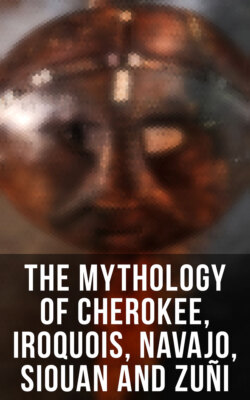Читать книгу The Mythology of Cherokee, Iroquois, Navajo, Siouan and Zuñi - James Mooney - Страница 245
На сайте Литреса книга снята с продажи.
The Birth of Sîñ
ОглавлениеThe Haida of British Columbia and the Queen Charlotte Islands possess a striking myth relating to the incarnation of the Sky-god, their principal deity. The daughter of a certain chief went one day to dig in the beach. After she had worked some time she dug up a cockle-shell. She was about to throw it to one side when she thought she heard a sound coming from it like that of a child crying. Examining the shell, she found a small baby inside. She carried it home and wrapped it in a warm covering, and tended it so carefully that it grew rapidly and soon began to walk.
She was sitting beside the child one day when he made a movement with his hand as if imitating the drawing of a bowstring, so to please him she took a copper bracelet from her arm and hammered it into the shape of a bow, which she strung and gave him along with two arrows. He was delighted with the tiny weapon, and immediately set out to hunt small game with it. Every day he returned to his foster-mother with some trophy of his skill. One day it was a goose, another a woodpecker, and another a blue jay.
One morning he awoke to find himself and his mother in a fine new house, with gorgeous door-posts splendidly carved and illuminated in rich reds, blues, and greens. The carpenter who had raised this fine building married his mother, and was very kind to him. He took the boy down to the sea-shore, and caused him to sit with his face looking toward the expanse of the Pacific. And so long as the lad looked across the boundless blue there was fair weather.
His father used to go fishing, and one day Sîñ—for such was the boy's name—expressed a wish to accompany him. They obtained devil-fish for bait, and proceeded to the fishing-ground, where the lad instructed his father to pronounce certain magical formulæ, the result of which was that their fishing-line was violently agitated and their canoe pulled round an adjacent island three times. When the disturbance stopped at last they pulled in the line and dragged out a monster covered with piles of halibut.
One day Sîñ went out wearing a wren-skin. His mother beheld him rise in stature until he soared above her and brooded like a bank of shining clouds over the ocean. Then he descended and donned the skin of a blue jay. Again he rose over the sea, and shone resplendently. Once more he soared upward, wearing the skin of a woodpecker, and the waves reflected a colour as of fire.
Then he said: "Mother, I shall see you no more. I am going away from you. When the sky looks like my face painted by my father there will be no wind. Then the fishing will be good."
His mother bade him farewell, sadly, yet with the proud knowledge that she had nurtured a divinity. But her sorrow increased when her husband intimated that it was time for him to depart as well. Her supernatural son and husband, however, left her a portion of their power. For when she sits by the inlet and loosens her robe the wind scurries down between the banks and the waves are ruffled with tempest; and the more she loosens the garment the greater is the storm. They call her in the Indian tongue Fine-weather-woman. But she dwells mostly in the winds, and when the cold morning airs draw up from the sea landward she makes an offering of feathers to her glorious son. The feathers are flakes of snow, and they serve to remind him that the world is weary for a glimpse of his golden face.
